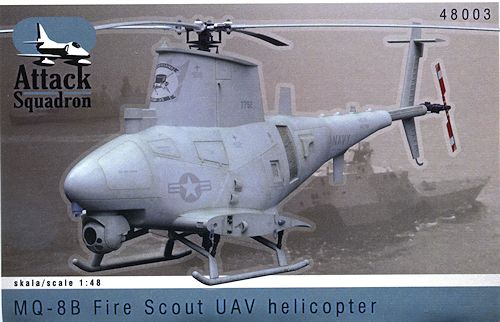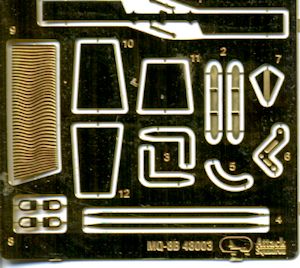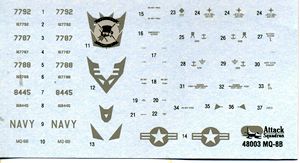
Attack Squadron 1/48 MQ-8B Fire Scout
| KIT#: | 48003 |
| PRICE: | $55.95 SRP |
| DECALS: | Four options |
| REVIEWER: | Scott Van Aken |
| NOTES: | Resin kit |

| HISTORY |
Although progress on the RQ-8A project had been regarded as satisfactory, the Navy decided the Fire Scout didn't meet their needs after all, and cut funding for production in December 2001. However, the development program continued, and Northrop Grumman pitched a range of improved configurations to anyone who was interested. As it turned out, the U.S. Army was very interested, awarding a contract for seven improved RQ-8B evaluation machines in late 2003. In 2006, it was redesignated MQ-8B.
The MQ-8B features a four-blade main rotor, in contrast to the larger-diameter three-blade rotor of the RQ-8A, to reduce noise and improve lift capacity and performance. The four-blade rotor had already been evaluated on Fire Scout prototypes. They boost gross takeoff weight by 500 pounds to 3,150 pounds (by 225 kg to 1,430 kg), with payloads of up to 700 pounds (320 kg) for short-range missions.
The MQ-8B is fitted with stub wings which serve both an aerodynamic purpose as well as an armament carriage location. Weapons to be carried include Hellfire missiles, Viper Strike laser-guided glide weapons, and, in particular, pods carrying the "Advanced Precision Kill Weapon System (APKWS)", a laser-guided 70 millimeter (2.75 inch) folding-fin rocket, which the Army saw as ideal for the modern battlefield. The Army was also interested in using the Fire Scout to carry up to 200 pounds (90 kg) of emergency supplies to troops in the field.
The MQ-8B is being modified to permit rapid swap out of payload configurations. The current sensor configuration of a day/night turret with a laser target designator will remain an option. Alternate sensor payloads in consideration include a TSAR with Moving Target Indicator (MTI) capability, a multispectral sensor, a SIGINT module, the Target Acquisition Minefield Detection System (ASTAMIDS), and the Tactical Common Data Link (TCDL). The Army wanted the Fire Scout to operate as an element of an integrated ground sensor network as well.
Production of the flight test airframes was initiated in April 2006 at the Northrop Grumman Unmanned Systems production plant in Moss Point, Mississippi. The Navy approved low-rate initial production. The first flight of the MQ-8B took place on 18 December 2006 at Naval Air Station Patuxent River.
The Army interest revived Navy interest in the program, with the Navy ordering eight Sea Scout MQ-8B derivatives for evaluation. In January 2010, the Army terminated its involvement with the Fire Scout, contending that the RQ-7 Shadow UAV could meet the Army's needs.
The MQ-8B complements the manned aviation detachments onboard Air Capable ships and is deployed along with either an SH-60B HSL/HSM detachment or a MH-60S HSC detachment. With the planned addition of RADAR, AIS, and weapons, the MQ-8B will provide many of the capabilities currently provided by the SH-60B. It will give the ship and embarked air detachment greater flexibility in meeting mission demands, and will free manned aircraft for those missions.
| THE KIT |
 Attack Squadron has been producing resin kits for a short while and this is the first of their products I have seen. I must say that I am quite impressed with the quality of the resin parts. In short, they are flawless with no molding glitches on any of the parts that I could see. There are several major parts with a multitude of smaller bits. The main pieces consist of the UAV's body, nose, tail boom, rotor fairing and the landing skids. There are more pieces for the fin, rotor blades and a myriad of smaller pieces.
Attack Squadron has been producing resin kits for a short while and this is the first of their products I have seen. I must say that I am quite impressed with the quality of the resin parts. In short, they are flawless with no molding glitches on any of the parts that I could see. There are several major parts with a multitude of smaller bits. The main pieces consist of the UAV's body, nose, tail boom, rotor fairing and the landing skids. There are more pieces for the fin, rotor blades and a myriad of smaller pieces.
 Included in these smaller bits are the only optional parts; inserts for the side of the fuselage. Photo etch is used for the large engine intake screen, the tail rotor and other smaller pieces such as radio antennas and pieces to enhance the rotor assembly and fuselage. The main rotor hub is a piece of 3D manufactured plastic, the first time I've seen something like this in a kit. A bag of clear parts includes the FLIR pod and navigation lights. Thanks to the bulk of the weight being in the main fuselage and nose, this should not cause issues with tail sitting.
Included in these smaller bits are the only optional parts; inserts for the side of the fuselage. Photo etch is used for the large engine intake screen, the tail rotor and other smaller pieces such as radio antennas and pieces to enhance the rotor assembly and fuselage. The main rotor hub is a piece of 3D manufactured plastic, the first time I've seen something like this in a kit. A bag of clear parts includes the FLIR pod and navigation lights. Thanks to the bulk of the weight being in the main fuselage and nose, this should not cause issues with tail sitting.
 Instructions are well drawn and in both Polish and English, providing detailed information on several aspects of the build. A second sheet is provided giving full exterior painting information as well as detals of the four markings options. They are all overall FS 36375 with rather small markings. The box art aircraft is from HSM-35 aboard the USS Fort Worth in May of 2013. Another is with HSL-42 on the USS Klakring in 2012. The other two options are with a detachment that was in Afghanistan in 2012. These two do not have the large rotor housing insignia and differ only in serial numbers. The decals are quite nicely printed and should prove to be quite thin and opaque.
Instructions are well drawn and in both Polish and English, providing detailed information on several aspects of the build. A second sheet is provided giving full exterior painting information as well as detals of the four markings options. They are all overall FS 36375 with rather small markings. The box art aircraft is from HSM-35 aboard the USS Fort Worth in May of 2013. Another is with HSL-42 on the USS Klakring in 2012. The other two options are with a detachment that was in Afghanistan in 2012. These two do not have the large rotor housing insignia and differ only in serial numbers. The decals are quite nicely printed and should prove to be quite thin and opaque.
| CONCLUSIONS |
To those of us who have not kept up to speed on these sorts of things, it very well seems that in the last 10 years there has been an explosion in different types of UAVs. These are now becoming a major component of both the regular US military as well as the guard and probably reserves as well. This is one of the more interesting aircraft and one that will not take up a ton of space on your display shelf.
| REFERENCES |
http://en.wikipedia.org/wiki/MQ-8_Fire_Scout
January 2014 My thanks to www.attacksquadron.pl for the preview kit. Visit the link for a list of retailers in your area.
If you would like your product reviewed fairly and fairly quickly, please contact the editor or see other details in the